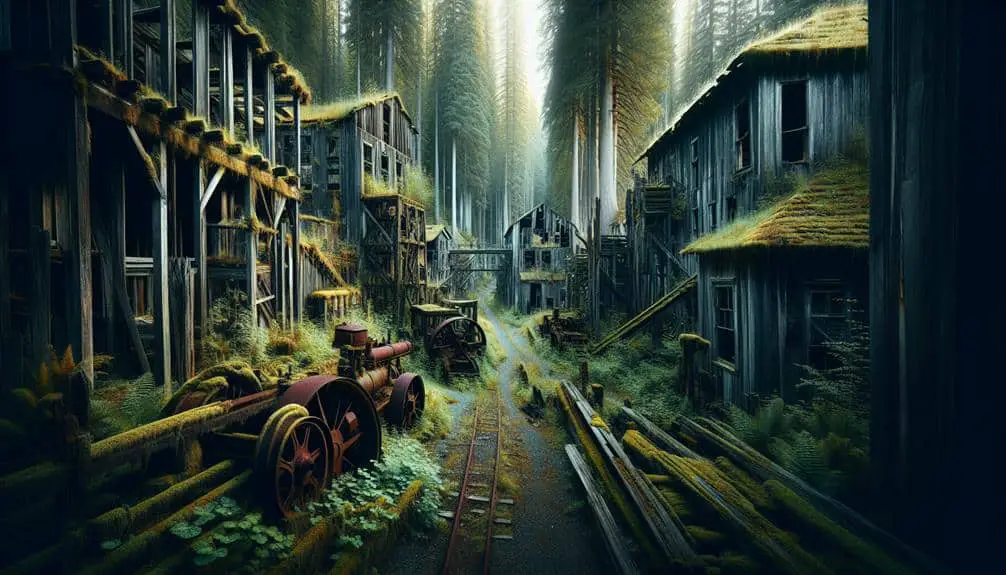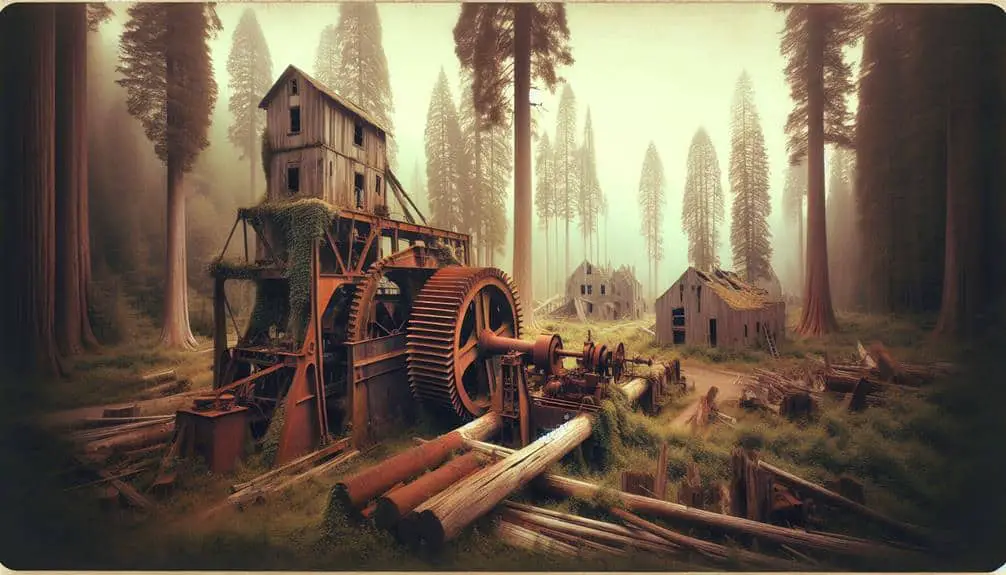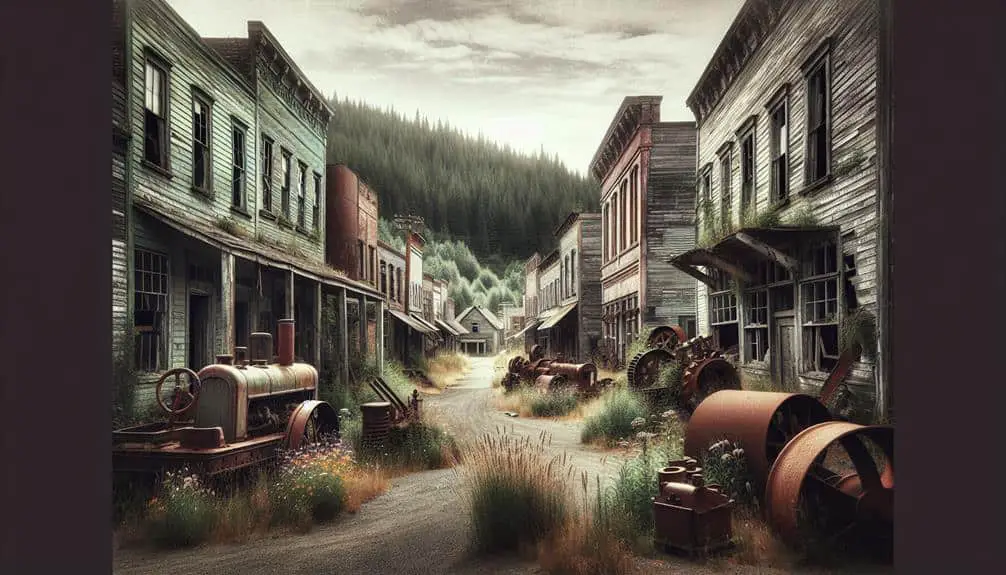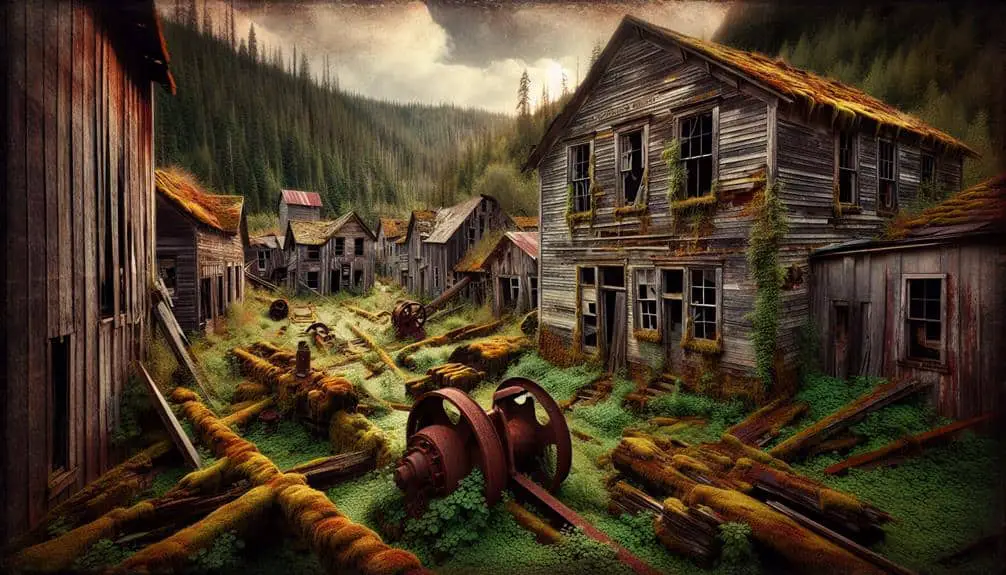Explore the eerie remnants of abandoned timber towns that dot the United States. Witness the silent echoes of a prosperous past in weathered sawmills and rustic homes, frozen in time. Rusty machinery and majestic smokestacks whisper tales of bygone eras amidst reclaiming nature. The delicate balance between progress and preservation is evident in these ghostly ruins. Discover the haunting history and heritage of these once-vibrant lumber communities, where restoration efforts are breathing life back into their rich past. Uncover the stories of hardworking settlers and the importance of responsible resource management.
Key Points
- Ghostly ruins reveal silent echoes of once-thriving timber towns.
- Abandoned sawmills and homes stand as haunting remnants of logging past.
- Rusty machinery and collapsed structures tell stories of bygone timber era.
- Forgotten railroad tracks hint at bustling activity in abandoned timber towns.
- Preservation efforts revive history and honor the legacy of early settlers.
Rise and Fall of Lumber Empires
During the late 19th and early 20th centuries, bustling lumber empires carved their way across the American landscape, shaping communities and economies in their wake. The timber barons of this era wielded immense power, controlling vast forests and employing thousands in the booming industry. These barons were titans of their time, building fortunes on the back of the nation's seemingly endless forests.
However, with great prosperity came great risk. The boom and bust cycle of the lumber industry was unforgiving, leading to the rapid rise and fall of many timber towns. As demand soared, forests were depleted at an alarming rate, causing economic downturns and leaving behind ghost towns scattered across the country.
Despite their eventual decline, the legacy of these lumber empires endures in the remnants of once-thriving communities. The rise and fall of these timber barons and their empires serve as a reminder of the delicate balance between progress and preservation in the quest for economic freedom.
Haunting Remnants of Logging Past
Explore the haunting remnants of logging past scattered throughout the United States, revealing the silent echoes of a bygone era. Ghostly ruins stand as eerie signs to the once-thriving logging communities that have long been abandoned. In these lost communities, weathered structures like old sawmills, decaying bunkhouses, and rusted machinery whisper tales of hard work and faded dreams.
Journeying through these areas, you can sense the spirits of loggers who toiled in harsh conditions, their presence lingering among the shadows of dilapidated buildings. Moss-covered remnants of log flumes and overgrown railroad tracks weave through the landscape, painting a picture of the bustling activity that once filled these now-desolate spaces.
The haunting beauty of these ghostly ruins serves as a reminder of the transient nature of industry and the resilience of nature in reclaiming what was once taken. As you explore these sites, take a moment to honor the legacy of those who built these communities and ponder the fleeting nature of human endeavors against the backdrop of time.
Forgotten Sawmills and Abandoned Homes
As you wander through the remnants of logging past, your gaze is drawn to forgotten sawmills and abandoned homes, silent witnesses to a fading era of industry and community. These rustic relics stand as evidence to the once-thriving timber towns that echoed with the sounds of saws and bustling life. The sawmills, now engulfed in decay and desolation, were once the heart of these settlements, where towering trees were transformed into lumber that built homes and communities.
The abandoned homes, with their peeling paint and broken windows, tell stories of families long gone, leaving behind only whispers of the lives they led. Walking through these empty streets, you can almost hear the echo of laughter and the hum of daily life that once filled these now deserted spaces.
Each creaking floorboard and weathered beam serves as a reminder of the resilience of these places, where nature and human endeavor collided. Amidst the quiet decay and desolation, there's a poignant beauty in these forgotten sawmills and abandoned homes, frozen in time, waiting to be rediscovered.
Echoes of Industry in the Wilderness
Amidst the untamed wilderness, remnants of once-thriving industries stand as silent witnesses to the human quest for progress and prosperity. As you explore these remote landscapes, you can't help but feel a sense of awe and respect for the industrial ruins that dot the natural scenery.
Here are five intriguing aspects that capture the essence of these abandoned timber towns:
- Rusty Machinery: Weathered gears and pulleys peek out from overgrown vegetation, telling stories of a bygone era.
- Collapsed Structures: Crumbling warehouses and decaying factories offer a glimpse into the challenges faced by early industrial pioneers.
- Forgotten Railroad Tracks: The echo of long-gone locomotives still lingers in the air, hinting at the bustling activity that once defined these areas.
- Majestic Smokestacks: Towering chimneys stand tall against the backdrop of towering trees, a poignant reminder of the heights to which industry once aspired.
- Quiet Resilience: Nature slowly reclaims what was once taken, showcasing the delicate balance between human innovation and the enduring power of the wilderness.
Reviving History: Preserving Timber Heritage
Preserving the heritage of abandoned timber towns involves a careful balance between restoration and conservation efforts that honor the legacy of the past while ensuring a sustainable future. Timber towns hold immense historical significance, representing the hard work and dedication of those who built thriving communities amidst the forests. Preservation endeavors aim to maintain the authenticity of these towns, allowing visitors to experience a glimpse of the past while also learning about the importance of sustainable practices.
By restoring old structures, such as sawmills and worker housing, these preservation initiatives breathe life back into the timber towns, showcasing their rich history. Through guided tours and educational programs, visitors can explore the remnants of a bygone era and gain a deeper appreciation for the challenges faced by early settlers.
Preserving timber heritage not only pays tribute to the laborers and families who once inhabited these towns but also serves as a reminder of the importance of responsible resource management. By embracing the past, we can create a more sustainable future for generations to come.
Frequently Asked Questions
What Safety Precautions Should Be Taken When Exploring Abandoned Timber Towns?
When exploring abandoned timber towns, remember to pack safety gear like sturdy boots, a flashlight, and first aid supplies. Always let someone know your plans, watch for hazards, and avoid risky areas. Stay safe!
Are There Any Reported Paranormal Occurrences in These Abandoned Timber Towns?
If you're curious about reported paranormal occurrences in abandoned timber towns, you might come across ghost sightings, haunted rumors, supernatural encounters, and paranormal investigations. These places can hold mysterious stories and eerie experiences.
How Do Local Communities Feel About the Preservation of These Historic Sites?
In considering the preservation of historic sites, local communities often show strong engagement. Their dedication to historical preservation stems from a desire for economic revitalization and tourism development, recognizing the value in preserving heritage.
Are There Any Efforts Being Made to Repurpose the Abandoned Sawmills and Homes in These Towns?
Efforts are underway to repurpose abandoned sawmills and homes in these towns. Urban renewal and revitalization initiatives aim to boost economic development and create new tourism opportunities. Your community can play a role in preserving history.
What Impact Did the Decline of the Timber Industry Have on the Surrounding Ecosystems and Wildlife?
When the timber industry declined, ecosystems suffered. Biodiversity was impacted, disrupting wildlife habitats. However, ecological restoration efforts are underway to revive these areas, aiming to restore balance and protect the environment for future generations.



